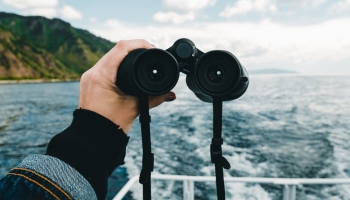The Best Rangefinder Binoculars of 2024 – Combining Optics for Precision Shooting and Hunting
For outdoorsmen, especially hunters and target shooters, rangefinder binoculars are essential. Rangefinder binoculars combine the magnification properties of regular binoculars with the distance estimation accuracy of a laser rangefinder.
Finding the best one among a multitude of options is often a daunting task. Here, we will provide you with all the information you need to choose the best rangefinder binoculars on the market to fit your needs, budget, and experience level.
Rangefinder Binoculars Buying Guide: Factors to Consider
 1. Maximum Ranging Distance
1. Maximum Ranging Distance
Maximum ranging distance is exactly as it sounds: the farthest distance you can see through binoculars. The amplitude of its laser beam determines the maximum ranging distance for a pair of rangefinder binoculars. The laser sends out a brief flash of light at your target object. The distance to that object is calculated by the amount of time it takes to return to the receiver on the binoculars.
2. Optical Performance
Optical performance is the ability of a pair of binoculars to show images in optimum brightness. To achieve the best optical performance, manufacturers apply layers of coating on the lenses to minimize light reflection, thus improving the image quality of the binoculars.
3. Objective Lens and Magnification
Most binoculars have a magnification between 7X and 10X. The number represents the number of times the image you see will be magnified. The main function of objective lenses (the ones furthest from your eye) is to collect light, which allows you to see distant objects with high resolution. Objective lenses with larger diameters let in more light and make the binoculars more efficient. However, a bigger objective lens means a bulkier binocular, and they can be harder to hold steady without a tripod or stand.
4. Field of View
Field of view is the width of the area viewed through the binoculars. It is measured in feet at a distance of 1,000 yards (or meters at 1,000 meters). Generally, the higher the magnification and smaller the objective, the narrower the field of view will be.
5. Data Accuracy
Different rangefinder models give varying types of data, such as elevation angles, temperature readings, and coordinates. Those that use laser beams give more accurate readings. Some models are very tech-heavy, and employ Bluetooth and Wifi capabilities.
6. Ballistic Configuration
A rangefinder binocular with a ballistic configuration allows input and calculation of data. The ballistic configuration feature typically offers multiple settings to adjust the level of data provided.
7. Weight
The weight of a pair of binoculars will factor into use in a number of ways. Carrying and transporting the device, as well as the ability to hold it steady with your hands, particularly while moving, are often concerns with heavier models. Stands, tripods, or special accessories to secure the transport and use of your binoculars might be necessary and should be considered when making your purchase.
8. Fog-resistance and Waterproof Features
Many times, you may find yourself using your rangefinder binoculars in foggy or moisture-heavy environments. To give clear images and maintain optimum performance, the lenses on binoculars have to be fog proof and water-resistant to prevent obstruction of the lenses by moisture.
Best Rangefinder Binoculars on the Market
1. Vortex Optics Fury HD 5000
 The Vortex Optics Fury HD 5000 has some unique features, some of which are not found in many other products in its class.
The Vortex Optics Fury HD 5000 has some unique features, some of which are not found in many other products in its class.
PROS: The brightness adjustment setting is one of the most beneficial elements of this device. It enables you to use these binoculars comfortably at any time of the day, and saves on power consumption while in use.
These rangefinder binoculars are fog- and waterproof, allowing for use in any environment without the worry of damage or reduced efficiency.
The ability to focus both the reticle and eyepieces independently affords high quality, clear images. This feature is atypical for a product in this price range. These rangefinder binoculars also come with angle-compensation technology, which is especially helpful to bow hunters.
CONS: The downsides to this device tend to be subjective, with some users finding the buttons too close together if wearing gloves, or clarity on the data display a little lacking.
2. Nikon Laserforce
 If you want a pair of rangefinder binoculars from a reputable brand known for its high-quality optics, then you should consider the Nikon Laserforce rangefinder binoculars.
If you want a pair of rangefinder binoculars from a reputable brand known for its high-quality optics, then you should consider the Nikon Laserforce rangefinder binoculars.
PROS: These binoculars can range deer at a distance of up to 1200 yards and detect trees up to 200 yards beyond that. They also give readings in 1-yard increments to distances of up to 100 yards away.
Compared to Swarovski and Zeiss models with the same capabilities and features, this model is easily the “most bang for your buck” at a third of the price.
CONS: When compared to its more expensive counterparts, some users find the ergonomics on this model a bit lacking.
3. Leica Geovid
 If you are into hunting or target practice, then this is probably one of the best options available. The Leica Geovid range reaches up to 3000 yards away and offers superb clarity.
If you are into hunting or target practice, then this is probably one of the best options available. The Leica Geovid range reaches up to 3000 yards away and offers superb clarity.
PROS: One of the most impressive features is the ABC Ballistic compensation system. With this system, you enter the data on the kind of bullets you are using, and the binoculars will calculate the best angle to hit your target.
It is made of a titanium-magnesium alloy, making it extremely shock-resistant. Its ergonomic design provides users with optimum grip. This model is extremely shock-resistant and is waterproof to a depth of 16 feet.
CONS: The protective titanium-magnesium alloy trades durability for heft. These rangefinder binoculars weigh a whopping 4.4 pounds.
4. Bushnell Fusion 1-Mile ARC Binocular Laser Rangefinder
 These rangefinder binoculars are from a reputable brand, and offer great range capabilities for the price. The Fusion 1-Mile ARC can detect objects up to 1700 yards away, making them a solid choice for hunting.
These rangefinder binoculars are from a reputable brand, and offer great range capabilities for the price. The Fusion 1-Mile ARC can detect objects up to 1700 yards away, making them a solid choice for hunting.
PROS: On top of having such a long range, they are accurate to within a yard at all distances. The easy-to-use technological features offer useful data, such as bullet drop and holdover information, at the touch of a button.
CONS: Durability is lacking in this model, making them a risky choice for outdoorsmen who adventure in all types of weather conditions.
5. ZEISS Victory 10 X 42 Binoculars
 Although they come at a pretty hefty price, the Zeiss Victory RF features match up to their price tag, with high-end technology not offered in most rangefinder binoculars.
Although they come at a pretty hefty price, the Zeiss Victory RF features match up to their price tag, with high-end technology not offered in most rangefinder binoculars.
PROS: One of the coolest features of this model is its Bluetooth technology, which allows you to connect to the ZEISS smartphone app to save information about the ammunitions and firearms you use. The information enables the Ballistic information system to assist in guiding your shot and provide all the information you need to make an accurate long-distance shot.
This pair also comes with an automatic brightness adjustment feature that not only gives optimal brightness for any light conditions, but also saves you a lot of time in the field.
CONS: The price may be justifiable only to a select few, as the high-end features may be lost on novices or casual outdoorsmen.
6. HOOWAY 7X 50 Marine
 Pretty much every pair of binoculars on this list has a laser rangefinder built in. The Hooway 7×50 Marine is the exception, using a rangefinder calculator system instead. This means you will use the reticle pointed at an object whose size you approximately know, and then calculate the approximate range that way. This takes much longer than the laser systems, but comes at a fraction of the price.
Pretty much every pair of binoculars on this list has a laser rangefinder built in. The Hooway 7×50 Marine is the exception, using a rangefinder calculator system instead. This means you will use the reticle pointed at an object whose size you approximately know, and then calculate the approximate range that way. This takes much longer than the laser systems, but comes at a fraction of the price.
PROS: It provides a 7X magnification and can view objects clearly without any stabilization issues. It also has an individual eyepiece focusing system that enables you to focus on objects while watching them at both medium and long distances. Its field of view spans up to 380 feet at 1000 yards.
This model is strongly geared toward marine environments, with a built-in illuminated compass, and it is fog- and waterproof. It is constructed to military standards, providing sturdiness and flotation capability.
All lenses on this pair of rangefinder binoculars are multicoated, providing you with crisp images through its 50mm objective lenses. It also comes with a Parro prism (BAK4) system.
CONS: Ideal use is limited to marine environments, and those seeking a sleek design or advanced technology will be dissatisfied.
7. Carl Zeiss Victory RF 10 X 54
 Once again, Zeiss brings the technology factor to a new level, with Bluetooth capability, target precision data, and a real-time ballistics computer.
Once again, Zeiss brings the technology factor to a new level, with Bluetooth capability, target precision data, and a real-time ballistics computer.
PROS: The Zeiss Victory RF 10x54mm rangefinder binoculars offer some of the most impressive features of any rangefinder binoculars in their class. They measure atmospheric conditions, including barometric pressure and temperature. The Ballistic information system gives you more accurate targeting information and allows for nine different profiles that enable it to calculate the ballistics of your specific ammunition effectively.
These binoculars have extremely efficient and clear optical capabilities, with 10X magnification and a 360-foot FOV. Lotu Tec and Zeiss T coatings offer impressive light-gathering capabilities, even in low light settings.
They also integrate with the ZEISS hunting app that is available for both android and apple devices. You can also access your ballistic information from your browser.
CONS: This model can be cost-prohibitive at over $3500, and the heavy tech elements may turn off more traditional users.
8. Steiner LRF 8x30mm
 The Steiner LRF Military is built to military specifications, making it one of the sturdiest options available. Outdoorsmen who enjoy extreme environments will appreciate this model’s durability.
The Steiner LRF Military is built to military specifications, making it one of the sturdiest options available. Outdoorsmen who enjoy extreme environments will appreciate this model’s durability.
PROS: This model can handle hard drops and is resistant to acid, salt, and oil corrosion. It can also be used in both desert and arctic environments. Its nitrogen purging utilizes a two-way valve design to ensure that no moisture can get in the binoculars, and it is waterproof up to 16 feet.
Equipped with a sports auto-focus, it allows users to set each eyepiece to their preferred vision, providing razor-sharp images at any distance. Hydrophobic molecular coating repels water and dirt, which is useful in extreme environments. With 8x magnification and weighing less than 2 pounds, this compact model is easy to hold while navigating rugged weather conditions.
CONS: Durability is the primary feature here, so users looking for a sleek or more tech-forward model will not find it here.
9. ATN BinoX-HD 4-16x65mm
 This is not your regular binocular. ATN’s BinoX-HD contains neither roof nor Porro prisms. Instead, it has a computer inside the body; hence, instead of looking through lenses, you look at two tiny high-resolution screens.
This is not your regular binocular. ATN’s BinoX-HD contains neither roof nor Porro prisms. Instead, it has a computer inside the body; hence, instead of looking through lenses, you look at two tiny high-resolution screens.
PROS: The screens provide crystal clear display as well as other information, such as compass heading and your angle up and down. Its internal gyroscope helps keep the image stable, even at maximum zoom (16X). Rather than use laser technology, it calculates the distance between you and an object based on its size. It also has an IR illuminator that enables you to see up to 300 yards at night.
This model comes with video, photo, and GPS capability, and all footage can be easily uploaded to a phone or tablet.
CONS: The batteries are an uncommon type and drain easily. Users will find themselves spending extra money to maintain use of these. Those who prefer a more traditional device will potentially find this model frustrating and unappealing.
Conclusion
Finding the best rangefinder binoculars relies heavily on intended use. Keeping features such as durability, technology aspects, and light capability in mind will make it easier to find the right fit for your budget and lifestyle.




